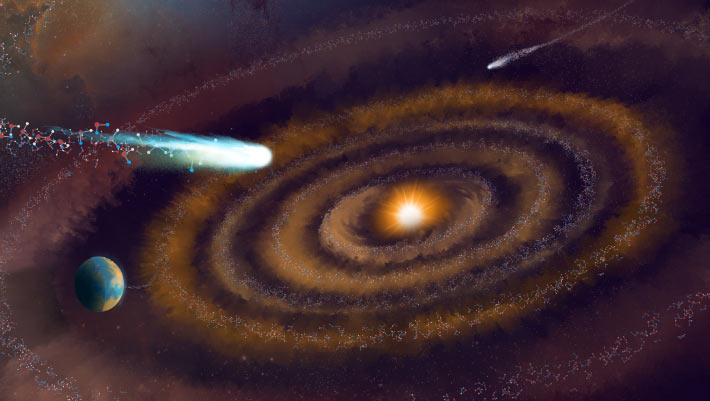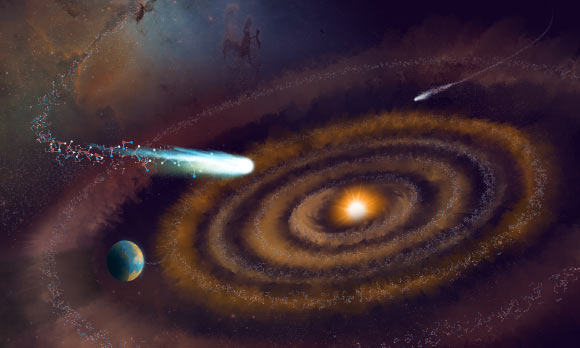Astronomers using the Atacama Large Millimeter/submillimeter Array (ALMA) have detected doubly deuterated water (D2O), or ‘heavy water,’ in the protoplanetary disk around V883 Orionis, a protostar located 1,300 light-years away in the constellation of Orion. This detection reveals that some of the water found in comets — and maybe even Earth — is older than the disk’s star itself, offering breakthrough insights into the history of water in our own Solar System.
This artist’s impression shows the evolution of heavy water molecules as they have been observed in giant molecular clouds, a planet forming-disk, and comets — before they eventually may have made their way to Earth. Image credit: NSF / AUI / NSF’s NRAO / P. Vosteen / B. Saxton.
Water may have been delivered to Earth via cometary and/or asteroid impacts, tracing the pristine material left over from the protoplanetary disk where our Solar System originated.
However, it is unclear whether the water ice on these bodies primarily formed in, for example, the protoplanetary disk phase or is much older and originated from the parent molecular cloud.
“Our detection indisputably demonstrates that the water seen in a planet-forming disk around V883 Orionis must be older than the central star and formed at the earliest stages of star and planet formation,” said Dr. Margot Leemker, an astronomer at the University of Milan.
“This presents a major breakthrough in understanding the journey of water through planet formation, and how this water made its way to our Solar System, and possibly Earth, through similar processes.”
The chemical fingerprinting of heavy water shows that these water molecules have survived the violent processes of star and planet formation, traveling billions of kilometers through space and time before, ending up in planetary systems like our own.
Instead of being destroyed and reformed in the disk, the bulk of this water is inherited from the earliest, coldest stages of star formation, a cosmic hand-me-down that may also be present on Earth today.
“Until now, we weren’t sure if most of the water in comets and planets formed fresh in young disks like V883 Orionis, or if it’s ‘pristine,’ originating from ancient interstellar clouds,” said Dr. John Tobin, an astronomer at NSF’s National Radio Astronomy Observatory.
“The detection of heavy water, using sensitive isotopologue ratios (D2O/H2O), proves the water’s ancient heritage and provides a missing link between clouds, disks, comets, and ultimately planets.”
“This finding is the first direct evidence of water’s interstellar journey from clouds to the materials that form planetary systems — unchanged and intact.”
The team’s paper was published this week in the journal Nature Astronomy.
_____
M. Leemker et al. Pristine ices in a planet-forming disk revealed by heavy water. Nat Astron, published online October 15, 2025; doi: 10.1038/s41550-025-02663-y

